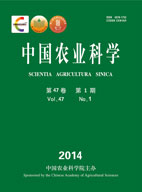-
Characterization of Soil Salinization Based on Canonical Correspondence Analysis Method in Gansu Yellow River Irrigation District of Northwest China
- YANG Si-Cun-1, PANG Huan-Cheng-2, WANG Cheng-Bao-1, LI Yu-Yi-2, HUO Lin-1, JIANG Wan-Li-1
-
Scientia Agricultura Sinica. 2014, 47(1):
100-110.
doi:10.3864/j.issn.0578-1752.2014.01.011
-
 Abstract
(
615 )
Abstract
(
615 )
 HTML
(
2 )
HTML
(
2 )
 PDF (462KB)
(
799
)
PDF (462KB)
(
799
)
 Save
Save
-
References |
Related Articles |
Metrics
【Objective】The objective of this study was to investigate the spatial distribution characteristics and quantitative relations of total salt content (TS), pH value and ion components so as to evaluate the relationship and correlation between them and their influences on types and distribution of saline-alkali land in Gansu Yellow River Irrigation District, Northwest China. 【Method】Take the typical irrigation area of Xingdian and Jingdian as research soil sampling area with sampling sites fully covered the newly reclaimed saline-alkali wasteland in the upper reaches, the mildly salinization of cultivated land in the middle reaches, the moderately severe salinization of cultivated land in the lower reaches and the salinization abandoned cropland in the whole irrigation area. And given more consideration to the differences between the types (sulfate type, chloride-sulfate type, sulfate-chloride type) and the degrees (mild, moderate, severe) of soil salinization when sampling. The conventional statistics method was used to evaluate the soil profile distribution of TS, pH and salt ion. The canonical correspondence analysis method was used to evaluate the quantitative relationships of TS, pH and the contents of salt ion, and the correlation coefficients, eigenvalues, cumulative percentage variance of TS, pH, salt ions between axis 1 and axis 2 of CCA in various soil layers. 【Result】 The irrigated soils of Gansu Yellow River Irrigation District are mild to severe salted, the salt content of 0-40 cm soil layer decreased with soil depth increase while the salt content of 40-80 cm soil layer increased with soil depth increases. The cation and anion in soil profile are Na+ and SO42 respectively -with pH value vary between 7.93 and 9.98. K+ and HCO3-, Ca2+ and Mg2+ are well linked in all soil layers, the correlation between Na+ and Cl- are enhanced with increment of soil depth, SO42- and Na+ are correlated negatively, the correlation between K+ and Na+ as well as SO42- , Cl- and HCO3 are not stronger in all soil layer-. At 0-100 cm soil profile, the spatial distribution of pH is mainly controlled by HCO3-, TS is mainly controlled by Na+, Cl- and SO42-, respectively. Different soil layers have diverse characteristics of soil salinization from that of the whole soil profile, the spatial distribution of pH and TS is mainly controlled by SO42- in 0-20 cm soil layer, by Cl- and Na+ in 20-40 cm soil layer, by Mg2+ in 60-80 cm soil layer, by Mg2+ and Cl- in 80-100 cm soil layer, by Ca2+, Mg2+, SO42- and HCO3- together in 40-60 cm soil layer individually. Axis1 and axis 2 of CCA reflects the changes of TS and pH value, respectively. The eigenvalues and cumulative percentage vary from 0.53 to 0.70 and 38.7% to 57.7% of axis 1, respectively, while that vary from 0.36 to 0.64 and 30.6% to 44.7% of axis 2 correspondingly. 【Conclusion】There are two processes of surface salt accumulation and bottom salt accumulation profiles in the saline cultivated land of Gansu Yellow River irrigation District. Newly reclaimed saline-alkali wasteland in the upper reaches and mild salinization of cultivated land in the middle reaches are given priority to surface accumulation profiles, and mild salinization of cultivated land in the middle reaches and moderately severe salinization of cultivated land in the lower reaches are given priority to bottom accumulation profiles. The salt content of 60-80 cm argillaceous cemented sand layer is as high as 93.7 g•kg-1, which has an important influence on the migration of water and salt and the distribution of salt ions, and is one of the main causes to lead soil to secondary salinization in the irrigation area. TS, Na+ and SO42- are the main factors that determine the type and distribution of saline-alkali land in Gansu Yellow River Irrigation District. Meanwhile, the canonical correspondence analysis method can intuitively give the relationship among various salt ions and between TS, pH and salt ion in two-dimensional ordination diagram of CCA by the length of the arrow, the quadrant, the angle between arrows, the distance between arrows and the triangle symbol, etc. And it also can determine the main controlling factors that influence the characters of different layers and the main factors that affect the type and distribution of saline-alkali land by using correlation coefficients, eigenvalues, cumulative percentage between TS, pH, salt ions and axis1/axis2 of CCA in various soil layers, so that, it is considered to be the more efficient scientific method for evaluation of the characteristics and improvement of saline-alkali land in Yellow River Irrigation Area.









